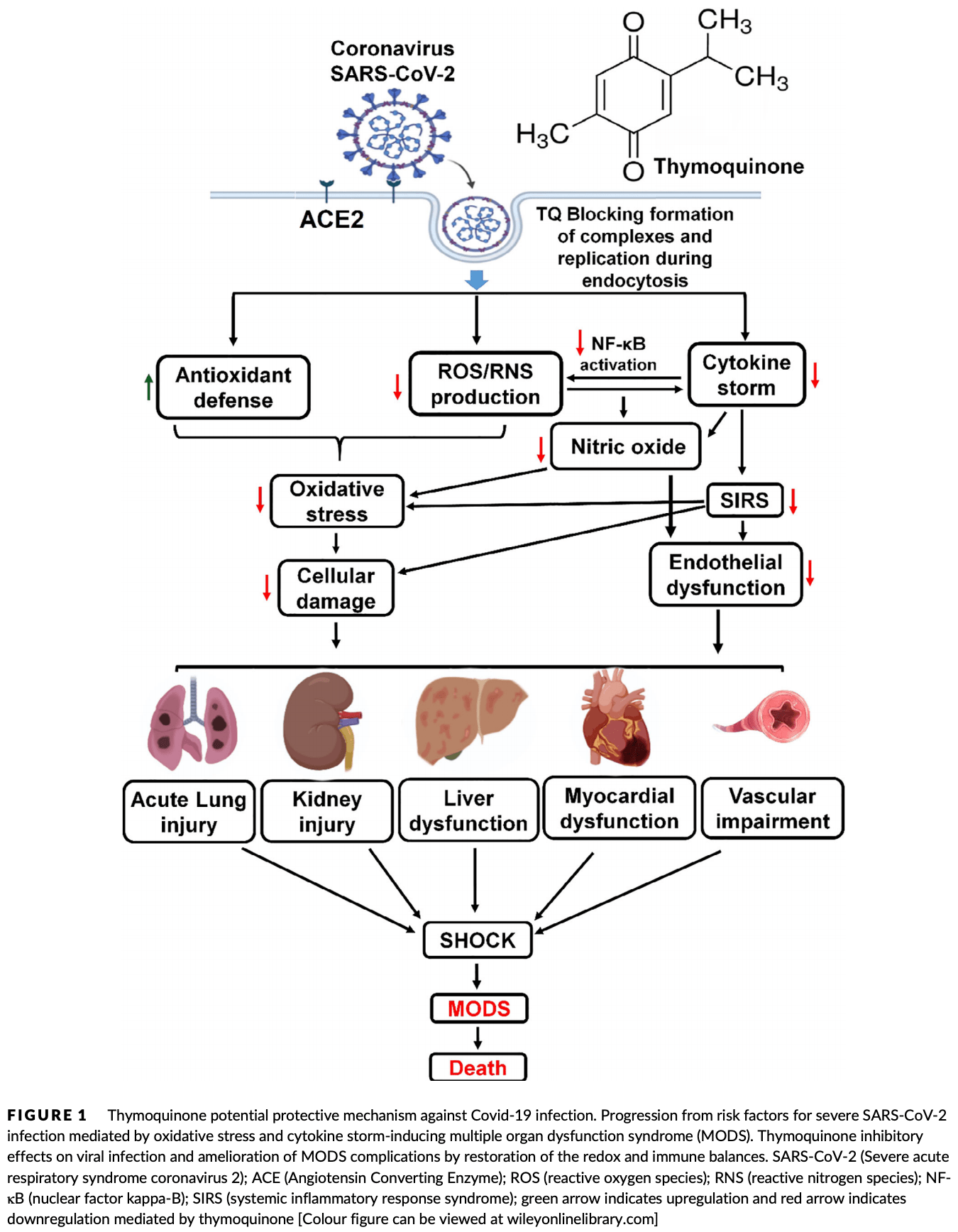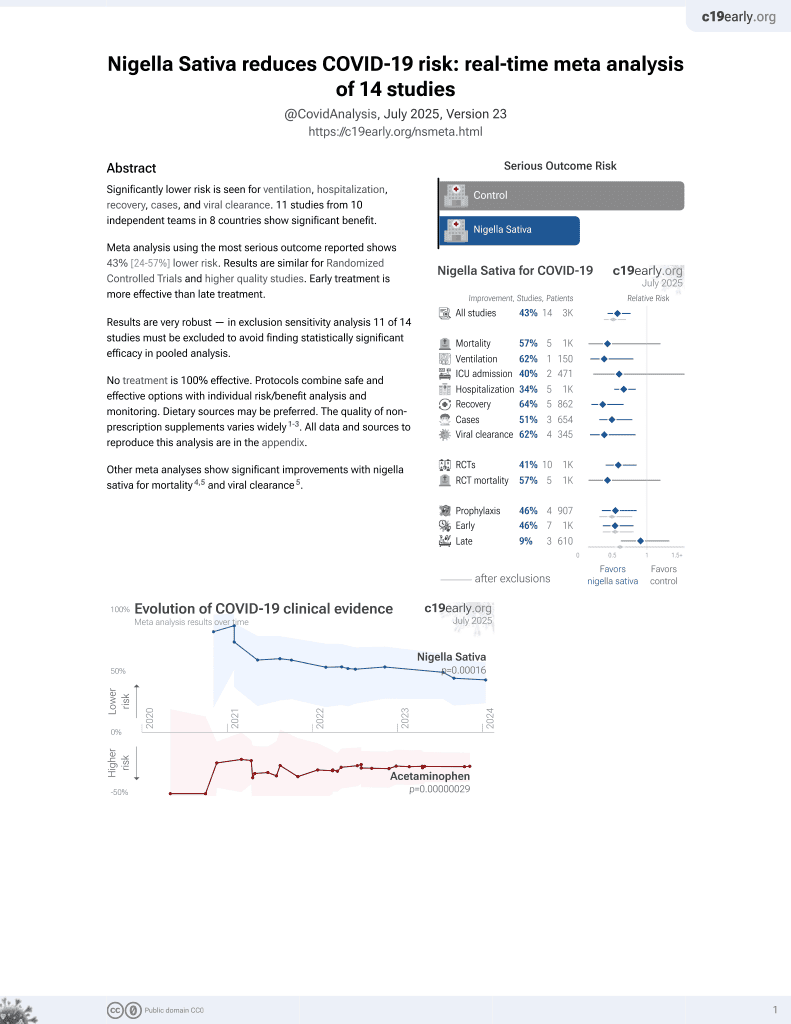
Covid-19 and thymoquinone: Connecting the dots
et al., Phytotherapy Research, doi:10.1002/ptr.6793, Jun 2020
13th treatment shown to reduce risk in
January 2021, now with p = 0.00016 from 14 studies.
No treatment is 100% effective. Protocols
combine treatments.
6,300+ studies for
210+ treatments. c19early.org
|
Review of the potential benefits of thymoquinone (a component of nigella sativa) for COVID-19, recommending clinical trials.
1.
Alsalahi et al., Immune stimulatory effect of Nigella sativa in healthy animal models: A systematic review and meta-analysis, Heliyon, doi:10.1016/j.heliyon.2024.e27390.
2.
Donzelli, A., Neglected Effective Early Therapies against COVID-19: Focus on Functional Foods and Related Active Substances. A Review, MDPI AG, doi:10.20944/preprints202312.1178.v1.
3.
Cyril et al., Nigella sativa and its chemical constituents: pre-clinical and clinical evidence for their potential anti-SARS-CoV-2 effects, Inflammopharmacology, doi:10.1007/s10787-023-01385-9.
4.
Al-Gabri et al., Therapeutic Potential of Thymoquinone and Its Nanoformulations in Pulmonary Injury: A Comprehensive Review, International Journal of Nanomedicine, doi:10.2147/IJN.S314321.
5.
Ahmad et al., The potential role of thymoquinone in preventing the cardiovascular complications of COVID-19, Vascular Pharmacology, doi:10.1016/j.vph.2021.106899.
6.
Shad et al., The role of thymoquinone, a major constituent of Nigella sativa, in the treatment of inflammatory and infectious diseases, Clinical and Experimental Pharmacology and Physiology, doi:10.1111/1440-1681.13553.
Ahmad et al., 26 Jun 2020, preprint, 4 authors.
Covid‐19 and thymoquinone: Connecting the dots
Phytotherapy Research, doi:10.1002/ptr.6793
At present, the medical approaches to cope with Covid-19 infection caused by the respiratory syndrome coronavirus 2 (SARS-CoV-2) are
CONFLICT OF INTEREST None.
AUTHOR CONTRIBUTIONS
Ajaz
References
Ahmad, Alkharfy, Jan, Ahad, Ansari et al., Thymoquinone treatment modulates the Nrf2/HO-1 signaling pathway and abrogates the inflammatory response in an animal model of lung fibrosis, Experimental Lung Research, doi:10.1080/01902148.2020.1726529
Akhondian, Kianifar, Raoofziaee, Moayedpour, Toosi et al., The effect of thymoquinone on intractable pediatric seizures (pilot study), Epilepsy Research, doi:10.1016/j.eplepsyres.2010.10.010
Alkharfy, Ahmad, Jan, Raish, Thymoquinone reduces mortality and suppresses early acute inflammatory markers of sepsis in a mouse model, Biomedicine & Pharmacotherapy, doi:10.1016/j.biopha.2018.01.028
Alkharfy, Ahmad, Raish, Vanhoutte, Thymoquinone modulates nitric oxide production and improves organ dysfunction of sepsis, Life Sciences, doi:10.1016/j.lfs.2015.08.007
Alkharfy, Al-Daghri, Al-Attas, Alokail, The protective effect of thymoquinone against sepsis syndrome morbidity and mortality in mice, International Immunopharmacology, doi:10.1016/j.intimp.2010.11.032
Banerjee, Kaseb, Wang, Kong, Mohammad et al., Antitumor activity of gemcitabine and oxaliplatin is augmented by thymoquinone in pancreatic cancer, Cancer Research, doi:10.1158/0008-5472.CAN-08-4235
Bouchentouf, Missoum, Identification of compounds from Nigella sativa as new potential inhibitors of 2019 novel corona virus (Covid-19): Molecular docking study, doi:10.26434/chemrxiv.12055716.v1
Chaieb, Kouidhi, Jrah, Mahdouani, Bakhrouf, Antibacterial activity of Thymoquinone, an active principle of Nigella sativa and its potency to prevent bacterial biofilm formation, BMC Complementary and Alternative Medicine, doi:10.1186/1472-6882-11-29
Coldewey, Rogazzo, Collino, Patel, Thiemermann, Inhibition of IκB kinase reduces the multiple organ dysfunction caused by sepsis in the mouse, Disease Models & Mechanisms, doi:10.1242/dmm.012435
Elfiky, Natural products may interfere with SARS-CoV-2 attachment to the host cell, Journal of Biomolecular Structure & Dynamics, doi:10.1080/07391102.2020.1761881
Forstermann, Sessa, Nitric oxide synthases: Regulation and function, Eur Heart J, doi:10.1093/eurheartj/ehr304
Galley, Oxidative stress and mitochondrial dysfunction in sepsis, British Journal of Anaesthesia, doi:10.1093/bja/aer093
Ghosh, May, Kopp, NF-κB and REL proteins: Evolutionarily conserved mediators of immune responses, Annual Review of Immunology, doi:10.1146/annurev.immunol.16.1.225
Green, Scheller, Marletta, Seguin, Klotz et al., Nitric oxide: Cytokine-regulation of nitric oxide in host resistance to intracellular pathogens, Immunology Letters, doi:10.1016/0165-2478(94)00158-8
Heinrich, Appendino, Efferth, Furst, Izzo et al., Best practice in research -Overcoming common challenges in phytopharmacological research, Journal of Ethnopharmacology, doi:10.1016/j.jep.2019.112230
Ichinose, Buys, Neilan, Furutani, Morgan et al., Cardiomyocyte-specific overexpression of nitric oxide synthase 3 prevents myocardial dysfunction in murine models of septic shock, Circulation Research, doi:10.1161/01.RES.0000253888.09574.7a
Ince, Mayeux, Nguyen, Gomez, Kellum et al., The endothelium in sepsis, Shock, doi:10.1097/SHK.0000000000000473
Jin, Cai, Cheng, Cheng, Deng et al., A rapid advice guideline for the diagnosis and treatment of 2019 novel coronavirus (2019-nCoV) infected pneumonia (standard version), Military Medical Research, doi:10.1186/s40779-020-0233-6
Kirkeboen, Strand, The role of nitric oxide in sepsis -An overview, Acta Anaesthesiologica Scandinavica, doi:10.1034/j.1399-6576.1999.430307.x
Liu, Malik, NF-kappa B activation as a pathological mechanism of septic shock and inflammation, American Journal of Physiology. Lung Cellular and Molecular Physiology, doi:10.1152/ajplung.00477.2005
Liu, Zhang, Joo, Sun, NF-κB signaling in inflammation, Signal Transduction and Targeted Therapy, doi:10.1038/sigtrans.2017.23
Munzel, Gori, Bruno, Taddei, Is oxidative stress a therapeutic target in cardiovascular disease?, European Heart Journal, doi:10.1093/eurheartj/ehq396
Rabuel, Samuel, Lortat-Jacob, Marotte, Lanone et al., Activation of the ubiquitin proteolytic pathway in human septic heart and diaphragm, Cardiovascular Pathology, doi:10.1016/j.carpath.2009.01.002
Salem, Hossain, Protective effect of black seed oil from Nigella sativa against murine cytomegalovirus infection, International Journal of Immunopharmacology, doi:10.1016/s0192-0561(00)00036-9
Schneider-Stock, Fakhoury, Zaki, El-Baba, Gali-Muhtasib, Thymoquinone: Fifty years of success in the battle against cancer models, Drug Discovery Today, doi:10.1016/j.drudis.2013.08.021
Schwarz, Oxidative stress during viral infection: A review, Free Radical Biology & Medicine, doi:10.1016/0891-5849(96)00131-1
Sekiou, Ismail, Zihad, Abdelhak, In-silico identification of potent inhibitors of COVID-19 main protease (M pro ) and Angiotensin converting enzyme 2 (ACE2) from natural products: Quercetin, Hispidulin, and Cirsimaritin exhibited better potential inhibition than Hydroxy-Chloroquine against COVID-19 main protease active site and ACE2, Chem-Rxiv, doi:10.26434/-chemrxiv.12181404.v1
Tsolaki, Makris, Mantzarlis, Zakynthinos, Sepsisinduced cardiomyopathy: Oxidative implications in the initiation and resolution of the damage, Oxidative Medicine and Cellular Longevity, doi:10.1155/2017/7393525
Ulasli, Gurses, Bayraktar, Yumrutas, Oztuzcu et al., The effects of Nigella sativa (Ns), Anthemis hyalina (Ah) and Citrus sinensis (Cs) extracts on the replication of coronavirus and the expression of TRP genes family, Molecular Biology Reports, doi:10.1007/s11033-014-3019-7
Umar, Munir, Subhan, Azam, Nisa et al., Protective and antiviral activities of Nigella sativa against avian influenza (H9N2) in turkeys, Journal of the Saudi Society of Agricultural Sciences, doi:10.1016/j.jssas.2016.09.004
DOI record:
{
"DOI": "10.1002/ptr.6793",
"ISSN": [
"0951-418X",
"1099-1573"
],
"URL": "http://dx.doi.org/10.1002/ptr.6793",
"alternative-id": [
"10.1002/ptr.6793"
],
"assertion": [
{
"group": {
"label": "Publication History",
"name": "publication_history"
},
"label": "Received",
"name": "received",
"order": 0,
"value": "2020-05-30"
},
{
"group": {
"label": "Publication History",
"name": "publication_history"
},
"label": "Accepted",
"name": "accepted",
"order": 1,
"value": "2020-06-16"
},
{
"group": {
"label": "Publication History",
"name": "publication_history"
},
"label": "Published",
"name": "published",
"order": 2,
"value": "2020-07-10"
}
],
"author": [
{
"affiliation": [
{
"name": "Department of Clinical Pharmacy, College of Pharmacy King Saud University Riyadh Saudi Arabia"
}
],
"family": "Ahmad",
"given": "Ajaz",
"sequence": "first"
},
{
"affiliation": [
{
"name": "Department of Clinical Pharmacy, College of Pharmacy King Saud University Riyadh Saudi Arabia"
}
],
"family": "Rehman",
"given": "Muneeb U.",
"sequence": "additional"
},
{
"affiliation": [
{
"name": "Department of Botany and Microbiology, College of Science King Saud University Riyadh Saudi Arabia"
}
],
"family": "Ahmad",
"given": "Parvaiz",
"sequence": "additional"
},
{
"ORCID": "http://orcid.org/0000-0002-9118-5076",
"affiliation": [
{
"name": "Department of Clinical Pharmacy, College of Pharmacy King Saud University Riyadh Saudi Arabia"
}
],
"authenticated-orcid": false,
"family": "Alkharfy",
"given": "Khalid M.",
"sequence": "additional"
}
],
"container-title": "Phytotherapy Research",
"container-title-short": "Phytotherapy Research",
"content-domain": {
"crossmark-restriction": true,
"domain": [
"onlinelibrary.wiley.com"
]
},
"created": {
"date-parts": [
[
2020,
6,
26
]
],
"date-time": "2020-06-26T08:00:03Z",
"timestamp": 1593158403000
},
"deposited": {
"date-parts": [
[
2023,
9,
4
]
],
"date-time": "2023-09-04T17:57:21Z",
"timestamp": 1693850241000
},
"indexed": {
"date-parts": [
[
2024,
3,
2
]
],
"date-time": "2024-03-02T09:17:30Z",
"timestamp": 1709371050541
},
"is-referenced-by-count": 31,
"issue": "11",
"issued": {
"date-parts": [
[
2020,
7,
10
]
]
},
"journal-issue": {
"issue": "11",
"published-print": {
"date-parts": [
[
2020,
11
]
]
}
},
"language": "en",
"license": [
{
"URL": "http://onlinelibrary.wiley.com/termsAndConditions#vor",
"content-version": "vor",
"delay-in-days": 0,
"start": {
"date-parts": [
[
2020,
7,
10
]
],
"date-time": "2020-07-10T00:00:00Z",
"timestamp": 1594339200000
}
}
],
"link": [
{
"URL": "https://api.wiley.com/onlinelibrary/tdm/v1/articles/10.1002%2Fptr.6793",
"content-type": "application/pdf",
"content-version": "vor",
"intended-application": "text-mining"
},
{
"URL": "https://onlinelibrary.wiley.com/doi/pdf/10.1002/ptr.6793",
"content-type": "application/pdf",
"content-version": "vor",
"intended-application": "text-mining"
},
{
"URL": "https://onlinelibrary.wiley.com/doi/full-xml/10.1002/ptr.6793",
"content-type": "application/xml",
"content-version": "vor",
"intended-application": "text-mining"
},
{
"URL": "https://onlinelibrary.wiley.com/doi/pdf/10.1002/ptr.6793",
"content-type": "unspecified",
"content-version": "vor",
"intended-application": "similarity-checking"
}
],
"member": "311",
"original-title": [],
"page": "2786-2789",
"prefix": "10.1002",
"published": {
"date-parts": [
[
2020,
7,
10
]
]
},
"published-online": {
"date-parts": [
[
2020,
7,
10
]
]
},
"published-print": {
"date-parts": [
[
2020,
11
]
]
},
"publisher": "Wiley",
"reference": [
{
"DOI": "10.1080/01902148.2020.1726529",
"doi-asserted-by": "publisher",
"key": "e_1_2_1_4_2_1"
},
{
"DOI": "10.1016/j.eplepsyres.2010.10.010",
"doi-asserted-by": "publisher",
"key": "e_1_2_1_4_3_1"
},
{
"DOI": "10.1016/j.biopha.2018.01.028",
"doi-asserted-by": "publisher",
"key": "e_1_2_1_4_4_1"
},
{
"DOI": "10.1016/j.lfs.2015.08.007",
"doi-asserted-by": "publisher",
"key": "e_1_2_1_4_5_1"
},
{
"DOI": "10.1016/j.intimp.2010.11.032",
"doi-asserted-by": "publisher",
"key": "e_1_2_1_4_6_1"
},
{
"DOI": "10.1158/0008-5472.CAN-08-4235",
"doi-asserted-by": "publisher",
"key": "e_1_2_1_4_7_1"
},
{
"DOI": "10.26434/chemrxiv.12055716",
"doi-asserted-by": "crossref",
"key": "e_1_2_1_4_8_1",
"unstructured": "Bouchentouf S. &Missoum N.(2020).Identification of compounds from Nigella sativa as new potential inhibitors of 2019 novel corona virus (Covid‐19): Molecular docking study. ChemRxiv Preprint. Retrieved from https://doi.org/10.26434/chemrxiv.12055716.v1"
},
{
"DOI": "10.1186/1472-6882-11-29",
"doi-asserted-by": "publisher",
"key": "e_1_2_1_4_9_1"
},
{
"DOI": "10.1242/dmm.012435",
"doi-asserted-by": "publisher",
"key": "e_1_2_1_4_10_1"
},
{
"DOI": "10.1080/07391102.2020.1761881",
"doi-asserted-by": "publisher",
"key": "e_1_2_1_4_11_1"
},
{
"DOI": "10.1093/eurheartj/ehr304",
"doi-asserted-by": "publisher",
"key": "e_1_2_1_4_12_1"
},
{
"DOI": "10.1093/bja/aer093",
"doi-asserted-by": "publisher",
"key": "e_1_2_1_4_13_1"
},
{
"DOI": "10.1146/annurev.immunol.16.1.225",
"doi-asserted-by": "publisher",
"key": "e_1_2_1_4_14_1"
},
{
"DOI": "10.1016/0165-2478(94)00158-8",
"doi-asserted-by": "publisher",
"key": "e_1_2_1_4_15_1"
},
{
"DOI": "10.1016/j.jep.2019.112230",
"doi-asserted-by": "publisher",
"key": "e_1_2_1_4_16_1"
},
{
"DOI": "10.1161/01.RES.0000253888.09574.7a",
"doi-asserted-by": "publisher",
"key": "e_1_2_1_4_17_1"
},
{
"DOI": "10.1097/SHK.0000000000000473",
"doi-asserted-by": "publisher",
"key": "e_1_2_1_4_18_1"
},
{
"DOI": "10.1186/s40779-020-0233-6",
"doi-asserted-by": "publisher",
"key": "e_1_2_1_4_19_1"
},
{
"DOI": "10.1034/j.1399-6576.1999.430307.x",
"doi-asserted-by": "publisher",
"key": "e_1_2_1_4_20_1"
},
{
"DOI": "10.1152/ajplung.00477.2005",
"doi-asserted-by": "publisher",
"key": "e_1_2_1_4_21_1"
},
{
"DOI": "10.1038/sigtrans.2017.23",
"doi-asserted-by": "publisher",
"key": "e_1_2_1_4_22_1"
},
{
"DOI": "10.1093/eurheartj/ehq396",
"doi-asserted-by": "publisher",
"key": "e_1_2_1_4_23_1"
},
{
"DOI": "10.1016/j.carpath.2009.01.002",
"doi-asserted-by": "publisher",
"key": "e_1_2_1_4_24_1"
},
{
"DOI": "10.1016/S0192-0561(00)00036-9",
"doi-asserted-by": "publisher",
"key": "e_1_2_1_4_25_1"
},
{
"DOI": "10.1016/j.drudis.2013.08.021",
"doi-asserted-by": "publisher",
"key": "e_1_2_1_4_26_1"
},
{
"DOI": "10.1016/0891-5849(96)00131-1",
"doi-asserted-by": "publisher",
"key": "e_1_2_1_4_27_1"
},
{
"DOI": "10.26434/chemrxiv.12181404.v1",
"doi-asserted-by": "crossref",
"key": "e_1_2_1_4_28_1",
"unstructured": "Sekiou O. Ismail B. Zihad B. &Abdelhak D.(2020).In‐silico identification of potent inhibitors of COVID‐19 main protease (Mpro) and Angiotensin converting enzyme 2 (ACE2) from natural products: Quercetin Hispidulin and Cirsimaritin exhibited better potential inhibition than Hydroxy‐Chloroquine against COVID‐19 main protease active site and ACE2. ChemRxiv. Preprint. Retrieved from https://doi.org/10.26434/chemrxiv.12181404.v1"
},
{
"DOI": "10.1155/2017/7393525",
"doi-asserted-by": "publisher",
"key": "e_1_2_1_4_29_1"
},
{
"DOI": "10.1007/s11033-014-3019-7",
"doi-asserted-by": "publisher",
"key": "e_1_2_1_4_30_1"
},
{
"DOI": "10.1016/j.jssas.2016.09.004",
"doi-asserted-by": "publisher",
"key": "e_1_2_1_4_31_1"
}
],
"reference-count": 30,
"references-count": 30,
"relation": {},
"resource": {
"primary": {
"URL": "https://onlinelibrary.wiley.com/doi/10.1002/ptr.6793"
}
},
"score": 1,
"short-title": [],
"source": "Crossref",
"subject": [],
"subtitle": [],
"title": "Covid‐19 and thymoquinone: Connecting the dots",
"type": "journal-article",
"update-policy": "http://dx.doi.org/10.1002/crossmark_policy",
"volume": "34"
}
